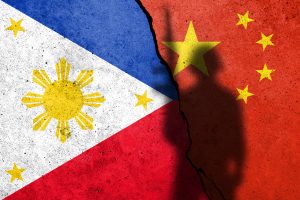The Philippines and the United States yesterday began a two-day joint maritime and air patrol in the South China Sea, after a year marked by a string of dangerous incidents in contested waters.
The maritime exercises between Manila and Washington are the second to take place in less than two months, after a three-day joint patrol in November. This took place near Mavulis island, the Philippines’ northernmost point, close to Taiwan, and in the disputed parts of the South China Sea, which has seen a rash of recent confrontations between Chinese and Philippine vessels.
According to Bloomberg, which cited the Philippine military, this week’s patrol involved four vessels and helicopters from the Philippine Navy. The U.S. Indo-Pacific command dispatched “an aircraft carrier, a cruiser, two destroyers, and multiple combat aircraft.”
Romeo Brawner, the commander of the Armed Forces of the Philippines (AFP), was quoted by the news agency as saying that this week’s patrol marked a “significant leap” in his country’s security alliance with the U.S. and its interoperability with the U.S. military.
“Our alliance is stronger than ever, sending a message to the world,” Brawner said. “We are advancing a rules-based international order and a free and open Indo-Pacific region in the face of regional challenges.”
The U.S.-Philippine patrols came as the Southern Theater Command of the People’s Liberation Army (PLA) announced that it would conduct its own patrol in the waterway on the same days. Writing on the command’s WeChat account, the PLA stated that the “routine” operations aimed to “resolutely safeguard China’s sovereignty, security, and maritime rights and interests.”
The PLA added that its forces were on “high alert” and “fully aware of and prepared for any military activities that spoil the South China Sea and create flashpoints.”
According to Reuters, China’s military did not say exactly where the patrols would be held. But according to one report, Chinese PLA Navy ships also shadowed the Philippine Navy patrol ship BRP Gregorio del Pilar while it was taking part in the joint patrol.
The dueling maritime patrols neatly encapsulate the growing tension in the South China Sea, where Chinese and Philippine vessels have been involved in a series of dangerous run-ins over the past year. Many of these have taken place in the waters around Second Thomas Shoal, a submerged feature within the Philippines’ exclusive economic zone in the Spratly Islands, where Manila maintains a small contingent of troops aboard the BRP Sierra Madre, a grounded warship.
Since the beginning of 2023, China has made increasingly forceful attempts to prevent the Philippine Navy from resupplying this outpost. This has resulted in a number of confrontations, including two in October and December, in which Chinese vessels collided with Philippine supply ships and coast guard vessels. The latter incident disabled a supply boat, which had to be towed back to Palawan island. On other occasions, Chinese vessels have also used high-powered water cannons and a military-grade laser to drive away Philippine supply flotillas.
As the incidents have unfolded at sea, recriminations and accusations have flown back and forth between Beijing and Manila, plunging relations to their worst point in nearly a decade. Last week, the Chinese government said that it would not turn a blind eye to repeated “provocations and harassment” by the Philippines, saying that Manila’s allegations that Chinese ships had used ramming tactics were “purely false hype.”
This come in response to Philippine denials that it was responsible for intensifying the current tensions. “The Philippines is not provoking conflict,” AFP spokesperson Medel Aguilar told state broadcaster PTV on December 26. “We follow international law and we are only implementing our domestic law, meaning the limits of our territorial waters and exclusive economic zone, where we have sovereign rights.”

































